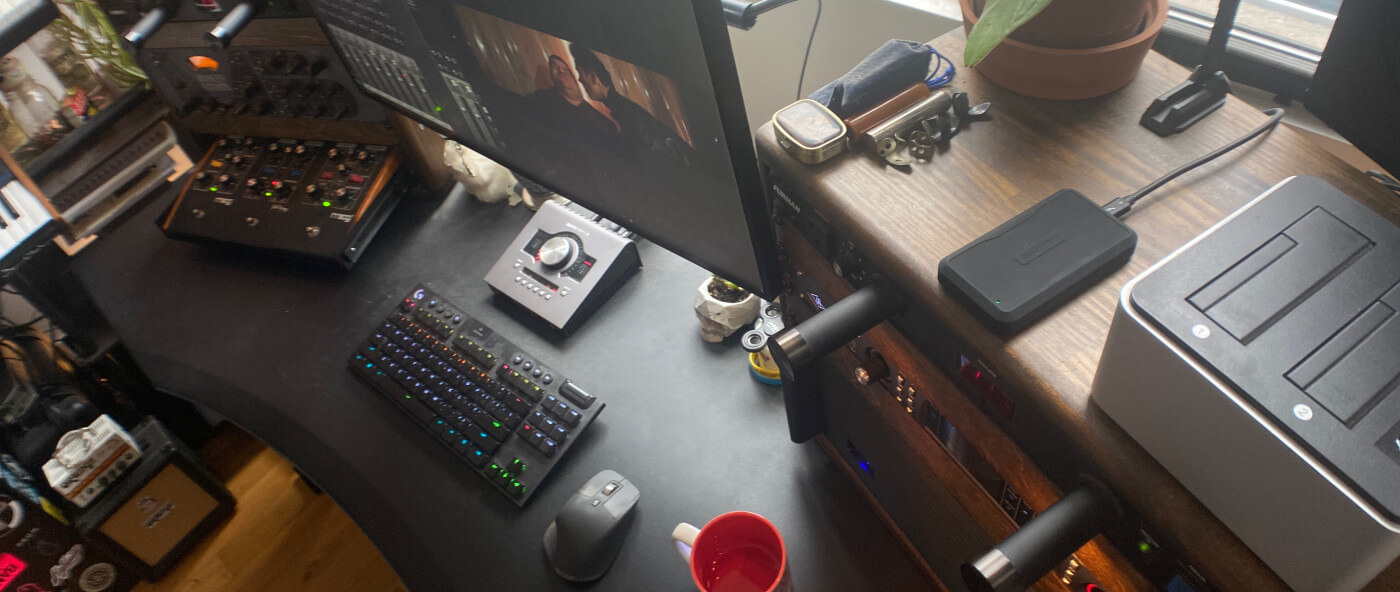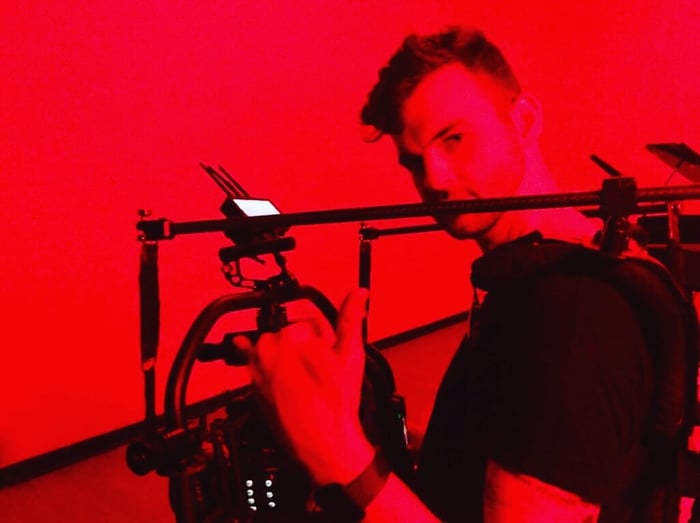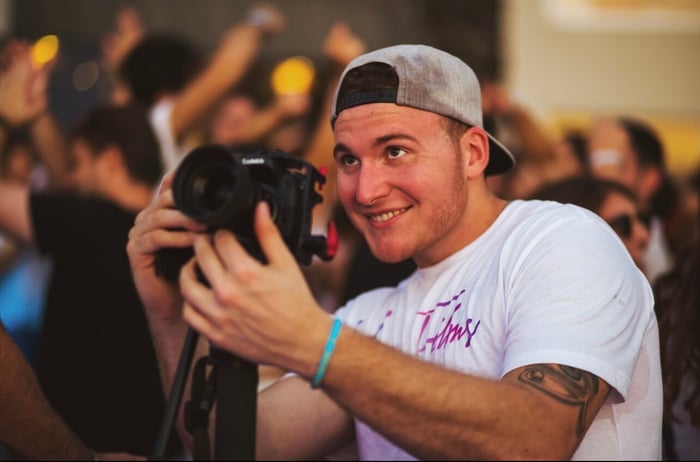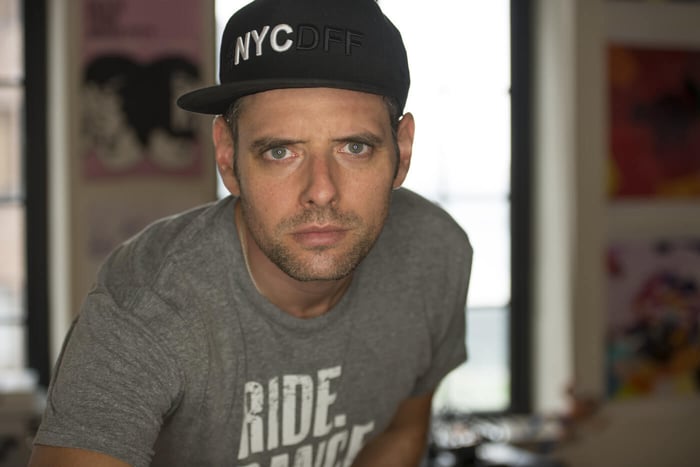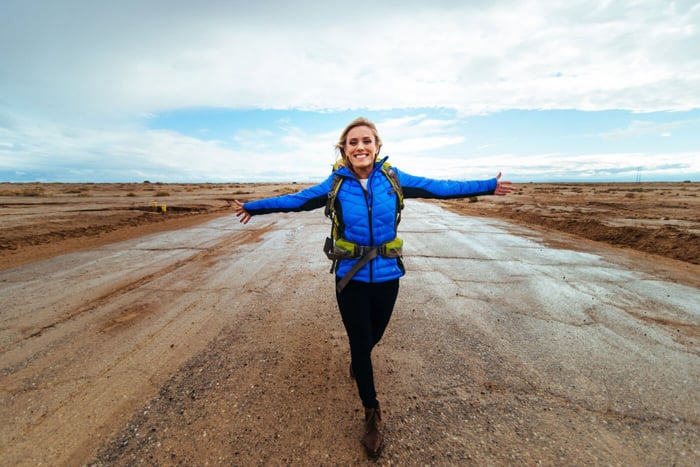We're back at it again with our Creator Spotlight series highlighting our community of creative professionals. This time, we sat down with Director of Photography & Artist Gabriel Stanley to discuss his career, journey and workflow.
If you were meeting someone at a bar and they asked you what you do, how would you actually describe yourself to them?
Gabriel: If you asked me when I first moved to NYC from Mississippi back in 2010, I would have said I'm a musician - but life in New York is sometimes unpredictable in the best ways. I found myself working in camera department on film sets as an assistant and then I started earning jobs as a DP; and that has changed my answer slightly. I’ve had great runs making music and touring but I’ve also had tenures working for people like Pharrell to Andy Cohen on a couple seasons of Watch What Happens live, so nowadays, I like to just say that I am an artist.

Talk to us about the beginnings of your career and how you got started.
Gabriel: I found a gig as the go-to AC for a commercial production company. They did everything from commercials for the super bowl to huge doc features with major studios. It was a really great way to learn about production environments and how to just “be” on set under any stress level. That quickly evolved into honing my skills as a cinematographer on music videos for friends in the scene. A good early example of this is a short parody I was asked to DP for Lorne Michaels Youtube focused production company, Above Average Presents. Through my work, I was eventually introduced to Pharell and his team and began working for his organization, I Am Other, helping to create and manage new content around the Girl album and Pharrell's launch of YouTube Red channel. We worked with everyone from Kaws to Nardwaur, and I still do projects with IAO as they come. My favorite though, was for sure when we filmed Pharrell listening to Maggie Rogers demos for the first time at NYU. The video broke reddit over the face he made at me behind the A-Cam when the song was first hitting the chorus. Maggie had a record, publishing, and management deal a few weeks later, and she's been crushing it ever since. In parallel to all of this, I was actively recording and performing as the artist PROM. We had gotten a great record deal and our first single out of the gate “Flickers” was on the Billboard charts; which was followed by a few great years of shows, tours, and an LP. I consider this point the end of the beginning :)
Can you tell us about some of your earliest influences as well as the creatives that inspire you today?
Gabriel: Pharrell was an early, and continues to be, a huge influence on me. He is a great example of how to leverage talent while compromising on the vision as little as possible. He projects humility at all times which is wild, all things considered. All three of these things, I believe, are vital when creating anything but especially when making music. I also had the privilege of getting to know and go on tour with George Clinton and Parliament Funkadelic a few years ago. George has such a huge presence on stage and his ability to make music that absolutely transfixes people is still something I try to draw from. My amazing label and management, Isotopia, got me the opportunity to write and release my first single with his granddaughters and members of P Funk for my artist project Paul Natural during the peak of COVID lockdown in 2020 which was really formative looking back.
As far as Cinematographers go, I have many contemporaries who constantly push and inspire me. Their work pushes boundaries (Ben Carey) and sets such a strong tone (Hunter Baker) that it makes me look twice at every movement, light, and lens choice I make on set. If it doesn't push the story forward, or elicit that one emotion that will make it stand out, then I do my best to move past it. These methods are in lock step with some of the great songwriting and arrangement styles I attempt to use when making music.

What's an example of an early project that really helped you find your style or push your creative comfort zone?
Gabriel: One of my favorite early projects was a music video I DP/Directed for X Ambassadors called "Unconsolable”. It starred Zosia Mamet alongside Sam, the lead singer who ends up a bloody mess by the end. Stylistically, this one was challenging to pull off with the budget we had, and the fact that it was an overnight shoot. That is all pretty par for the course in music videos but this is where I really fell in love with using camera movement to accomplish longer more impactful shots with less cutting. Overall this project is totally “of its time” when it comes to the saturation and VFX choices but I think it still stands out seeing as it's now been a decade and everyone involved has gone on to do great things.
My first major film with a theatrical release as a DP was Lez Bomb. It allowed me the opportunity to work with Producer Bobby Farrely alongside my longtime collaborator Jenna Laurenzo (Girl Night Stand, Watch What Happens Live) who wrote, starred, and directed an absolutely amazing cast of legends (RIP Cloris!). We actually ended up shooting in a motel that her grandfather had built and her mother still runs along with her childhood home. That fact made it fun but also very challenging to light twelve principle cast members for certain scenes. After this project I was wholly changed as a DP and haven't looked back since. I was able to use many lighting methods I had always admired in feature work and really learned how to manage a larger crew in chaotic scenarios over multiple weeks.
I felt there was such a massive paradigm shift in music in 2010 from Indie to what it is today. This is when I first started diving into electronic & pop music. An early project that really set me on a path was actually a track I made for a film that was never released. I had this great hook and guitar lick but the song was missing that cinematic dimension. Once I figured out that it was the addition of sub-bass instruments and panning methods- I was hooked. I showed this little demo to my future bandmate Ella Zoller in PROM after seeing fun. (the band) and Miniature Tigers live in NYC. Dave Weingarten was their drummer at the time and eventually ended up producing our entire catalog. That song became our release Darlin, which really put PROM on the map before anything else.
Can you talk a bit about those methods?
Gabriel: There are things you see on set that seem insane but once you are tasked with accomplishing something similar for your director - some of them start to really make sense. I like to joke about how as I get older my lenses get wider and my light sources get further away. During Lez Bomb I really embraced lighting from outside the set and using modifiers to fill in the blanks for a more natural look. In comedy you really don't want the camera to feel like its own character (too many moves, weird angles that add unnecessary drama, etc) because the punchline will almost always land best in a two-shot or something similar. And being able to reframe or give the actors physical space to move freely is important - putting most of the lights outside blasting through a window or something similar strikes this balance. I was also over-using stabilizers and dollies in my work up until this point. One of my favorite operators of all time and now owner of Metro Camera Cars pointed out to me that if “Everyone is 30 ft tall on a screen then we can’t be taking the audience on a roller coaster ride into Bruce Dern's nostril.” Keeping that all in mind. Since I picked it up as a way to get my zoomies out during the COVID lockdown in NYC, I have really come to love combining the gimbals we all know and love with a Onewheel (no not that one, the one you ride like a snowboard). You can accomplish shots that are too tight for a crane or wirecam and/or require you to be more nimble than an Agito or some type of armcar. I had the pleasure of shooting a few scenes like this for Julien Rosefelts new film Euphoria, which premiered this past fall starring Giancarlo Espisito and Cate Blanchett as the voice of a tiger, and is currently playing in limited theatrical release worldwide.
The methods in music just like filmmaking have really evolved at a breakneck pace since I entered the industry over a decade ago. Everything is more powerful, if it used to be analog it's now digital, and if it was early digital it's now reappropriated as kitsch. I feel this shift most in the way I have made music through the years. Just something as simple as not having to plug an instrument in everytime you want to use it or being able to copy/paste an immensely complicated effects chain at a whim are things that used to only be available to people with access to major studios with small armies of engineers at the ready. This allows for basically complete (and sometimes intimidating) freedom of choice in where to take a song and the story surrounding it. There is less down time and more ways things can go. It has really challenged my ability to focus while at the same time opening up more possibilities in what I can achieve at home by myself or with a couple other people. Personally I like my inputs to be as analog as possible and then I stay in the box for the rest of the signal chain while arranging and mixing, with one exception, I use my old Moogerfooger pedals as sends because they just bring something extra special in that I haven't found a good plugin substitute for yet.

Tell us abut the relationship between music and filmmaking. How has that influenced your work?
Gabriel: They are symbiotic in many ways. Especially, the mentality where you have to be a self starter and shameless self promoter. These are very aligned for both disciplines. They also inform each other in huge ways. I don't think I know anyone who writes scripts that isn't an avid music fan or uses it actively to pace out their works. I also don't think you will find many serious musicians who aren't big movie buffs. On tour, the movies you select to watch together between shows shape the whole tone of the experience, and inevitably creates inside jokes that last forever.
There is another huge factor in the relationship between music and filmmaking - each discipline deeply respects the other and those of us who tow the line between fields, I feel, you really get the best of both worlds. There is a very c'est la vie vibe to the process of making music and being “in the studio.” Today this can mean anything from writing in a room at Electric Lady or someone's Brooklyn or Silverlake apartment that's been stuffed with synths and rack gear with a 2017 Macbook (best year for i/o & stability) swimming in a sea of cables of - running the whole show. This mentality can really come in handy in the much more regimented workflow of shooting with a large crew. Keeping things light and flexible can be a huge asset in sustained, high stress environments like feature or commercial work. Likewise, I draw huge inspiration for my arrangements and honestly, best practices when it comes to data management, that allow for creativity to not be interrupted by the eternal search for that file you were “100% sure was in THIS folder.
I would be remiss if I didn't mention the role that gear plays equally in both disciplines. Learning the nuances of the tools of each trade and attempting to understand their inner workings can unlock your potential for truly great work. However, and I am sure I am not alone in this, but the focus on the tools of the trade instead of the end user of each craft can also be a huge hindrance. This is something I try to be very self aware about - like using a gimbal for a closeup shot just because it's on set; or running crucial parts of your mix through a melange of analog signal chains that can never be replicated no matter how bad you'll need to later on.
How do you balance this double life with a career in both music and filmmaking?
Gabriel: Luckily in each career you can accept or decline jobs/gigs at your own risk. Folks that are purely musicians have “album cycles” that revolve around recording, releasing and then touring. For me, I get to lean into the film side when I’m between cycles - and am able to let one pursuit inspire the other.
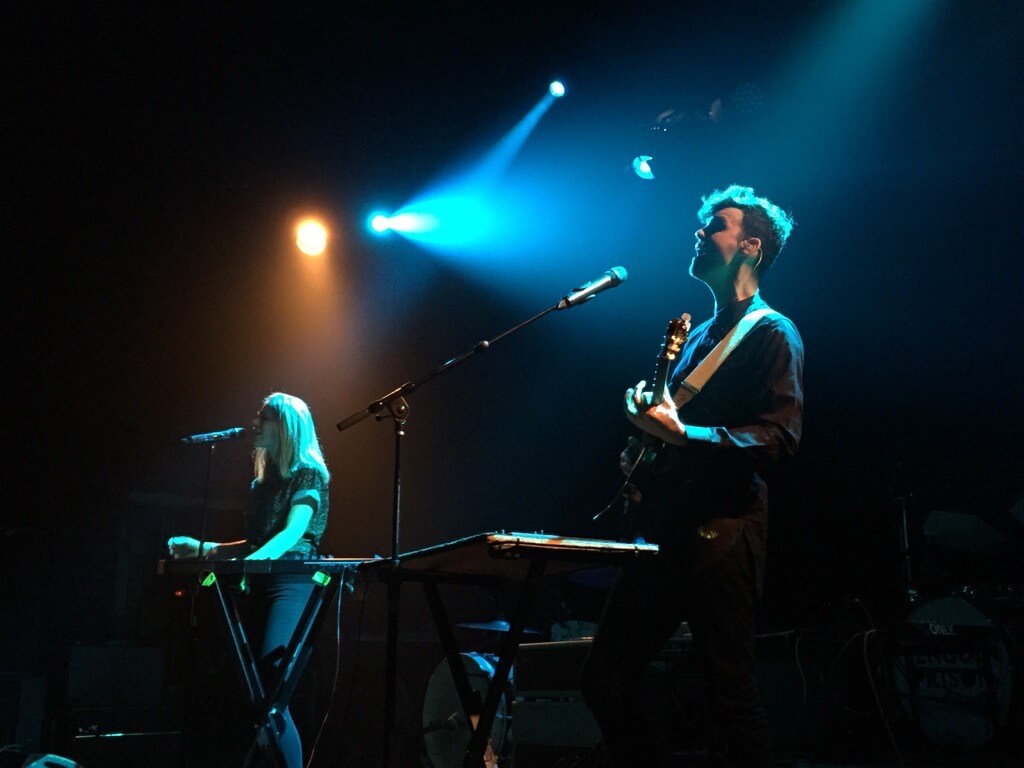
What role do you feel the evolution of technology has played in shaping various aspects of your career? Does anything in particular excite you about where technology's going right now?
Gabriel: Beyond words. The fact that I even can pull off having two careers is a testament to how integrated tech and art have become. I am super excited about where access to 3d printing and smaller format CNC machines is driving the filmmaking community. Especially in the world of stabilizers and just making all our work more ergonomic in general. The amount of camera assistants showing up on set today with bits from Camera Caviar, Ignite Digi, or one of the other awesome gray market innovators is just so helpful. Our work is chaotic and unpredictable, so everything one can do to abstract themselves from fact, and focus on the shot and why you are really there, is sacrosanct. One thing that can't be overlooked is the increase in data rates overall. I love the ability to push my camera's raw codec to accomplish a really great look and not have to worry about my producers losing their shirts on DIT overtime or lost data on a spinning drive thanks to the current generation of SSD’s. I started a company over COVID called Rig City that exclusively rents camera stabilization, support, and AKS because there is such a need and market in NYC for specialized shops that are following along with the community which is really exploding due the the access to better and more cost effective tools/tech.
Can you touch on some of your more recent career highlights? What were some of the most gratifying moments of your career?
Gabriel: Most recently I got the chance to work on Julien Rosefelts new film Euphoria starring Giancarlo Espisito and Cate Blanchett as the voice of a tiger; where I used my onewheel and a Movi pro to get a shot of a skateboarder bombing down Broadway in Brooklyn where we weave through traffic, go into a C-Town Parking lot and through the aisles. We also used a 5-Camera array to create a shot of a choir that fills a theater space in 360 which was really something to behold when it finally premiered last fall. I have been working a lot with anamorphics recently, very much inspired by some of my favorite classic films and reinvigorated by my work on Point Gods for showtime which really opened me up to their uses, especially on Movi. Another recent favorite, This past christmas I shot a one take christmas film with Jenna Laurenzo. It's the third in a series of films called Girl Night Stand. They follow a couple in various phases of off-again on-again relationships; this last one the performances played out perfectly in a oner from the Movi (and my gaffer dancing around behind us with lighting changes) has made it one of my new favorites. I also got to write the music for it with Jenna! Commercially, I really enjoyed doing this recent spot for Tiffanys with my friend Alioune. His style and aesthetics are unmistakable and we were able to shoot this around downtown NYC with ease on my Technovision 1.5x zoom I love from P+S Technik that I have been using with full frame sensors to get a really dynamic image when cropping into a 9:16 or 1:1 ratio for today's deliverables.
This past year I finished releasing an EP under the artist name Paul Natural. Started a few years ago with a remix of Cautious Clay’s “Call me.”This inspired me to do an album of all features that included a little snapshot of the scene in Brooklyn right before 2020. The DP work was taking me to interesting places, I even ended up on a world tour with Parliament Funkadelic tour filming and writing with artists along the way, coming full circle with the first track, Swept. This EP is a collection of songs made during that time and finished in lockdown in NYC. This actually influenced how I did the music videos; I wanted the ability to do things I couldn't do with a camera (not to mention we were all locked down) in a classic music video setting. I also wanted visuals that would compliment the songs and not distract from what is already happening. Each one is deeply symbolic and something I discussed with each artist on their respective tracks. The animation style is one I have long admired and wanted to work in; it was masterminded by animator Luke Mollemon (of Great Good Fine Okay) and really pushed the whole project to the next level.
One of the most gratifying moments as a DP was when Lez Bomb premiered at The Geena Davis Bentonville Festival and won the grand jury prize (along with others) before it went to theaters and eventually to Netflix and now Peacock. There was also a great moment in 2017 when I was asked to DP a piece for the Billboard Hot 100 Music festival at Jones Beach in NYC where I had also been booked to play a set as my band PROM. It was awesome to get that energy boost of playing and then get to go shoot some of my favorite artists and friends back in our little studio on the water that was constructed around an 80’s VW Van. A perfect melding of both worlds doesn't always happen organically.

What are some of your challenges as a filmmaker?
Gabriel: Keeping and nurturing the personal and professional network as the work can be all consuming. Making space for procrastination, boredom, and shared extracurriculars are the absolute key to creativity and connection between peers - and carving out dedicated time to these things is fully at odds with an active DP’s lifestyle. I try to go to every meet-up or studio party each year at a minimum in NYC.
Can you tell us about the importance of reliable, fast storage on set or on the road?
Gabriel: It was pretty early on in my career as a camera assistant that we got to know which portable drives were reliable on set, and which ones showed up dead-on-arrival 30% of the time. Glyph was always the go-to ask from production (and still is for me), especially when the shift from disks to solid state drives happened. Also as a pro working in NYC, it helps to know that the company is based in NY, and that the data was covered in the event of a defect. As everyone who works on set knows, literally nothing is more stressful than the whole crew watching a 2nd AC or DIT sweat over a drive that wont stay mounted after you have all worked in the elements for 14 hrs for what’s on those cards - and you can’t leave till it’s backed up!
